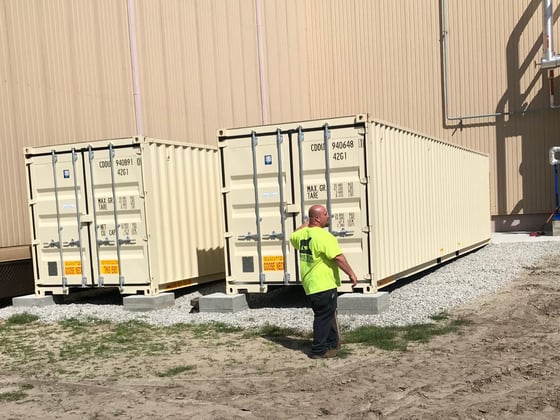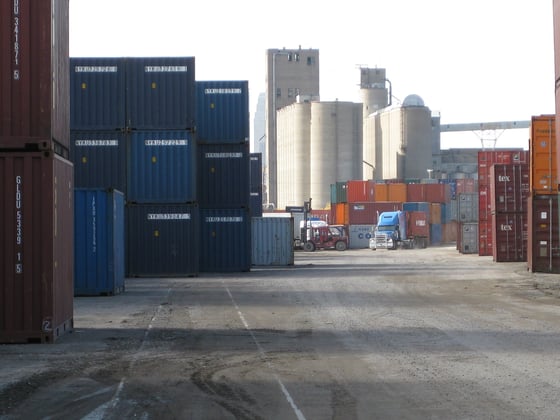Key Factors That Impact the Cost of a Shipping Container
Shipping containers are extremely useful for many uses. They can be used for anything from storage to offices, houses, and businesses. If you can imagine it, it can probably be done! So, if you're considering a shipping container for storage, transporting or modifying for your next exciting project, then naturally, you're wondering, how much will it cost me? In this blog, we're breaking down the many factors that influence the pricing of shipping containers so you can have a better understanding of the costs of obtaining the right container for you.

How Shipping Container Pricing is Determined Globally
What many individuals may not realize is that the shipping and leasing lines actually determine shipping container pricing. Shipping lines are companies that own and operate ships that transport containers that transport goods worldwide. Leasing lines are companies that make containers and lease them to shipping lines. Shipping lines and leasing lines project what their shipping volumes will be and what quantities of containers they will need to fill the ships that will be transporting goods in the upcoming months, quarters and year.
While each shipping line has a general age range for when they sell containers to the aftermarket, that final decision is more dictated by market demands:
- If the shipping lines need more containers to fill their cargo demands, they may choose to hold onto containers longer than usual.
- Shipping lines and leasing lines may move their containers from one location to another rather than sell them when demand for containers is particularly high in one market or another. We saw this during the pandemic when many empty containers were shipped back to China to keep up with the high demand for manufactured goods during that time.
- If shipping lines are leasing containers from leasing lines, when the lease is up, they have a few options:
- Extend the lease if the shipping line still need containers.
- Return the container to wherever the nearest container depot in their agreement is.

Key Factors that Influence Shipping Container Pricing

Location
Shipping containers are sold in specific cities where the shipping and leasing lines are established to sell them. In the US, there are approximately 30 cities where shipping lines have facilities to store, repair, and sell containers. These cities are where the containers are stored between trips. The containers are stored in depots where they are checked through to see if there is damage to them that needs repair. However, this process does not happen in every city where containers pass through on the rail/truck. Pricing will vary between these cities. Larger port cities or larger cities that are hubs generally will be cheaper, whereas more inland cities tend to be more expensive.
Condition
The condition of a container is another important factor that plays a role in the cost of a shipping container. There are five main industry categories of containers, which include:

Used containers come in a variety of grades, but it is hard to know what is wind- and water-tight and what is cargo-worthy from looking at them.

Cargo-worthy 40’ in front of others that are not.
- As-Is. Ultimately, this means that the container has issues. Generally, the issues are extensive and expensive enough that the shipping or leasing line isn't willing to pay to fix them. Most of the time, the discount on getting an "as-is" container isn't worth the problem you are taking on. Also, there aren't a ton of these floating around as these come about because of an accident or other issue.
- Wind and Water Tight. This category indicates that the container is around 8-20 years old, with no leaks or holes. However, it may have some rust and dents as it is a used container.
- Cargo-Worthy. A cargo-worthy container is everything the wind- and water-tight container is, plus is structurally sound enough to be used for shipping again. These containers will still have rust and dents. Cosmetically, there is no difference between wind- and water-tight and cargo-worthy.
- IICL. This designation is from the Institute of International Container Lessors (IICL) They are very similar to cargo-worthy, as they are structurally sound enough to be shipped overseas and checks a few more boxes than cargo-worthy on a surveyor's checklist than cargo-worthy. For most laypeople, you would not be able to spot the differences. These tend to be more mid-life containers than end-of-life containers. We don't see these as often in the used container market.
- One-Trip. One-trip shipping containers are new as we get in the US. Since all containers are made in China, the container has made one trip to the US. These containers are generally made with a few "extras" like having higher handles to be more convenient, more vents, or lockboxes on the doors. Most are a neutral color like beige or gray and do not have shipping line markings on them. However, you should always confirm this when buying one-trip containers, as that is not always the case. Sometimes, these are referred to as new containers, but they have technically been used once in the process of getting them to the US. Because of that, you will see the wear and tear of the containers being moved from the factory to being filled up and then moving through the ports, rail, and trucking systems to make their way to their end destination. That can make some minor scraps or dents on the container or tire marks on the floor inside the container.
It's important to note that all used containers will have rust and dents.
Although the shipping container industry does not use a letter rating system, some companies will use an A, B, C rating for containers. However, this is not standardized in the industry and, therefore, does not have significant weight behind it. Shipping lines and leasing lines don't use these systems as they are generally focused on cosmetics, which are not a part of any of the ratings for the shipping lines.
Pros and Cons of Buying Used Shipping Containers
Shipping Containers from Super Cubes
At Super Cubes, we typically purchase cargo-worthy, wind- and water-tight containers to ensure that we have containers with good floors, good door seals, and a good roof. We try to buy cargo-worthy containers to sell as wind- and water-tight containers when possible. However, if you need a cargo-worthy container for export, we do charge extra for that because we need to ensure that it has a neutral prefix and the logos are neutral.
Sizes and Speciality Containers
Of course, the size of the shipping container you need will also impact the price of your container. Additionally, specialty containers that are not the default standard sizes can come at a higher cost. Here are the different sizes and specialty containers you may find and how their size influences the cost of the shipping container.
Standard Sizes:
- 20’ Standard Container - The smallest standard size container - this is traditionally the least expensive container.
- 40’ Standard Container and 40’ High Cube - Usually have similar pricing in used containers, but increasingly, the standards are less available in one-trip containers.
Specialty Sizes:
10' Container - These have to be sent over as two 10s stuck together as a 20' for transport, and then when they get here, they are split apart, and the missing end walls are added in. This process makes them more expensive than a 20' container.-
- 20' high cube - are a specialty container
- Double-door (doors on both ends) are generally a good deal for a special configuration.
- Open-tops and hard tops - containers with a tarp for a top or a removable metal roof, respectively, generally come in used options, are less common and have to come from wherever they can be found.
- Open-sides -
- Traditional open-sides have one long side of the container that opens fully with no obstructions. However, they are the most expensive option. The flooring is bigger on full open sides. On the 40’ high cube open-side has a rise on the open-side of the container but not on the side with the wall, making for a very uneven floor. Traditional open-sides come in 20', 20' high cube and 40' high cube options.
- 40HC - 4-door/3-posts - These containers have 4 sets of doors on one 40’ side of the container separated by 3 posts. They have a regular floor so you get the same internal height as a regular 40’ high cube.

20’ hard top shipping container.

Inside a 40’ open-top shows how the bows hold up the tarp that serves as a roof.

40’ high cube full open-side has a thicker floor than most containers.

40’ high cube 4-door/3-post has 4 sets of doors separated by 3 posts.


Delivery
There are 2 major factors to consider when looking at your delivery rate: the type of delivery and the distance of the delivery. Both will affect the rate you are being quoted.
Type of Delivery
What kind of truck will be delivering the container to your location? Is it a tilt-bed truck that will set the container on the ground? Is it a flatbed, step-deck, chassis or low-boy truck delivering the container? If it is a flatbed, step-deck, chassis or low-boy, you will need equipment to lift the container off of the truck at your location. If you have that equipment, that is great and it can save you some money. But if you don’t, renting that equipment will probably cost more than the difference in the rates.
Additionally side loaders and boom trucks are specialized vehicles that simplify unloading, but they are typically more expensive and not available in many markets.It is the first critical question to ask about the delivery rate being quoted.

20’ Chassis cannot set down containers
Find out more about in our blog: Container Delivery Basics: Tilt-Bed, Flat-Bed, or Chassis
Distance of the Delivery
Where is the container coming from? Trucking rates are all based on distance. If the container is going across town, that will be much cheaper than going across the state. As we said earlier, all containers come out of container cities one way or another. Your delivery rate may be out of one of those cities or the company quoting you may have moved it from one of those cities to their location.
For Super Cubes, we always bring the containers out of those set container cities and will quote ground-level delivery unless you tell us you can offload the container or you are too far from one of those cities for us to be able to do that. That means we’ll be able to offer a lower cost on the container, but our delivery may be higher as we may not be as close to you as some around the corner from.
You may get quotes from companies that are closer to you. They have paid to move their containers to their location. That means their container rates will be higher to include that cost of moving the containers to their location, but the final delivery rate will be lower.
To compare apple to apples, look at the bottom line - what is the total of the container and the delivery together? Are the both the same kind of containers and the same kind of delivery?
The Company You Are Purchasing From
Who you buy your container from will clearly influence the price you pay. However, it's important to be aware that too-good-to-be-true pricing is often a sign of a potential scam, not a reputable shipping container company.
If you are comparing prices and 1-2 companies are significantly lower than everyone else, that should raise some red flags. Dig into that quote and ask a few questions:
- If you are looking at pictures of the container, do the picture and description match? Often scammers will put the picture of a fancy specialty container, the description of a basic used container and a price that is well below market for either the specialty container or the basic container. It isn’t just a bait and switch, it is a scam. They are pulling in people with the picture, they are trying to get “savvy customers” with the description, but there is no container.
- Look at the description and price of the container and where it is starting. Is it the same as everyone else? If it is coming from a different city or state from everyone else, why is that? No one moves containers across multiple states if they don’t need to. If they are a nation-wide seller, they should have containers in a container city near you - which would be the same as some of your other quotes.
- If you see that the container is coming from 7 states away, but the delivery rate says $150, that should raise some red flags for you. Could you drive your car that far for that much money? Probably not. So do you think a company could run an expensive truck, pay for the fuel and a driver to go that distance for that much? Definitely not.
Remember, if it sounds too good to be true, it probably is. Unfortunately, in the shipping container industry, there are a lot of scammers, which is why working with a reputable vendor is so important.
Reputable Company vs. Scammer
Here are some important considerations why choosing a shipping container vendor. Make sure the company quoting you is legitimate.
- Do they have a real address (not just a PO Box) and a phone number?
- Do they offer various ways to contact them? (If it's all chat or text, that's a red flag!)
Information They Share
- Are they providing clear details about the container and delivery?
- Do the container description and photos match?
What They Ask You
- Are they asking where you are located and about your delivery area? Not confirming your delivery address is a red flag!
- Most reputable companies will have similar total rates.
Red Flags
- If a company's price is way lower than others, be cautious.
- Rushing you to make a quick decision is a warning sign.
- A container coming from far away when others are closer should raise concerns.

You can find even more information in our blog: 5 Steps to Verify Your Shipping Container Vendor's Legitimacy
When purchasing a shipping container, there are many factors that impact the price. Understanding these variables is key to finding the right container for your needs and budget. If you have questions or would like a quote from a reliable vendor, our team at Super Cubes is here to help.
Super Cubes is a family-owned business located in Minneapolis, MN, that provides containers anywhere in the continental US. We offer personalized service for individuals and businesses, providing high-quality containers at competitive prices. With nationwide facilities, we can modify and deliver containers close to you. Contact our experienced team for your next container project.
October 1, 2024

